Clinical characteristics and prognostic analysis of primary extranodal non-Hodgkin lymphoma of the head and neck
- PMID: 38604163
- PMCID: PMC11087136
- DOI: 10.18632/aging.205726
Clinical characteristics and prognostic analysis of primary extranodal non-Hodgkin lymphoma of the head and neck
Abstract
Objective: Primary extranodal non-Hodgkin's lymphoma (PE-NHL) of the head and neck is the second common site of extranodal lymphoma, accounting for approximately one-third of all extranodal non-Hodgkin's lymphoma (E-NHL). However, in recent years, large-scale PE-NHL case studies in China and worldwide are rare and not comprehensive enough. This work analyzed the clinical manifestations, pathological features, immunophenotypes and diagnosis of PE-NHL, as well as the factors affecting the treatment and prognosis.
Methods: A retrospective study was performed on 74 patients who were diagnosed with head and neck PE-NHL and treated for the first time. The clinical manifestations, pathological features, and immunophenotypes were summarized, and the factors related to the treatment and prognosis were analyzed.
Results: The most common site of this disease was the Waldeyer's ring, followed by the nasal cavity. Diffuse large B-cell lymphoma was the most common type, followed by extranodal NK T-cell lymphoma nasal type. The 1-year, 2-year, and 5-year progression-free survival (PFS) rates were 76.4%, 67.9%, and 59.3%. The 1-year, 2-year, and 5-year overall survival (OS) rates were 89.4%, 85.6%, and 63.2%. ECOG score ≥ 2, Ann Arbor stage III or IV and IPI risk stratification identifying patients as the high-risk group were independent risk factors affecting the OS of patients with PE-NHL of the head and neck.
Conclusions: The most common site of PE-NHL in these Chinese patients was the Waldeyer's ring, but the incidence in the nasal cavity was higher than that reported in Western countries. Radiotherapy combined with chemotherapy had better efficacy than chemotherapy alone, and the prognosis depended on the ECOG score and clinical stage. IPI had a better prognostic value in patients in the high-risk group of head and neck PE-NHL.
Keywords: clinical characteristics; extranodal non-Hodgkin’s lymphoma; head and neck neoplasms; primary; prognostic factor.
Conflict of interest statement
Figures



Similar articles
-
Clinical characteristics, pathological distribution, and prognostic factors in non-Hodgkin lymphoma of Waldeyer's ring: nationwide Korean study.Korean J Intern Med. 2014 May;29(3):352-60. doi: 10.3904/kjim.2014.29.3.352. Epub 2014 Apr 29. Korean J Intern Med. 2014. PMID: 24851070 Free PMC article.
-
Localized non-Hodgkin's lymphoma of Waldeyer's ring: clinical features, management, and prognosis of 130 adult patients.Head Neck. 2001 Jul;23(7):547-58. doi: 10.1002/hed.1077. Head Neck. 2001. PMID: 11400243
-
Characteristics and prognostic factors for head and neck non-Hodgkin's lymphoma in Chinese patients.J Laryngol Otol. 2013 Jul;127(7):699-704. doi: 10.1017/S0022215113001217. Epub 2013 Jun 6. J Laryngol Otol. 2013. PMID: 23738972
-
Analysis of the Clinicopathologic Characteristics and Prognosis of Head and Neck Lymphoma.Anal Cell Pathol (Amst). 2022 Feb 22;2022:4936099. doi: 10.1155/2022/4936099. eCollection 2022. Anal Cell Pathol (Amst). 2022. PMID: 35242496 Free PMC article. Review.
-
Non-Hodgkin lymphoma of the Waldeyer's ring: clinicopathologic and therapeutic issues.Leuk Lymphoma. 2008 Dec;49(12):2263-71. doi: 10.1080/10428190802493686. Leuk Lymphoma. 2008. PMID: 19052973 Review.
Cited by
-
Value of radiomics and deep learning feature fusion models based on dce-mri in distinguishing sinonasal squamous cell carcinoma from lymphoma.Front Oncol. 2024 Nov 21;14:1489973. doi: 10.3389/fonc.2024.1489973. eCollection 2024. Front Oncol. 2024. PMID: 39640273 Free PMC article.
References
Publication types
MeSH terms
LinkOut - more resources
Full Text Sources
Medical

